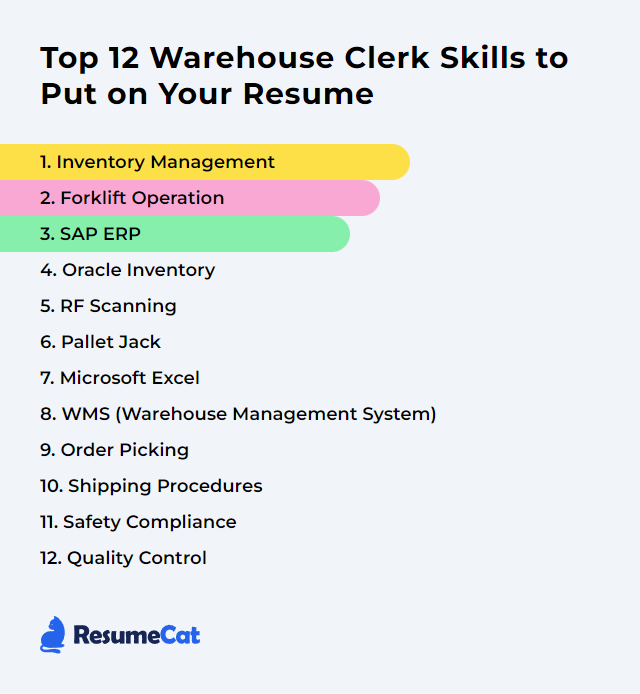Top 12 Warehouse Clerk Skills to Put on Your Resume
In today's logistics and supply chain world, warehouse clerks keep the heartbeat steady. The right skills on a resume don’t just look good—they signal reliability, accuracy, and the grit to keep product flowing without drama. Inventory balanced. Orders out the door. Fewer errors. More momentum.
Warehouse Clerk Skills
- Inventory Management
- Forklift Operation
- SAP ERP
- Oracle Inventory
- RF Scanning
- Pallet Jack
- Microsoft Excel
- WMS (Warehouse Management System)
- Order Picking
- Shipping Procedures
- Safety Compliance
- Quality Control
1. Inventory Management
Inventory management is the control center for goods moving in, stored, and shipped out. It’s the balance between accuracy and speed—tracking stock levels, organizing storage, and keeping every item accounted for.
Why It's Important
Without tight inventory control, you get stockouts, overstock, wasted time, and unhappy customers. Strong management keeps carrying costs in check, orders accurate, and shelves honest.
How to Improve Inventory Management Skills
Make the numbers tell the truth. Then keep them that way.
- Adopt real-time tracking: Barcode or RFID scanning cuts manual errors and keeps counts current.
- Cycle counting over chaos: Run frequent cycle counts (ABC prioritized) to avoid painful full physicals and catch variances early.
- Dial in reorder points: Use lead time, demand variability, and safety stock to set reorder points that actually work.
- Use FIFO/FEFO where it matters: Especially for perishables or date-sensitive goods, move the right units first.
- Optimize slotting: Put high-velocity items close to pack-out. Group related SKUs. Shrink walking time.
- Tighten receiving: Verify quantities, condition, and labeling at the dock. Bad receipts poison the whole system.
- Watch the metrics: Track inventory accuracy, shrink, days on hand, and order fill rate. Act on what drifts.
- Strengthen supplier signals: Share demand, confirm lead times, and hold partners to ASN/label accuracy.
Do this consistently and the warehouse calms down. Fewer surprises. Faster turns.
How to Display Inventory Management Skills on Your Resume

2. Forklift Operation
Operating a powered industrial truck to lift, move, and stage goods safely and efficiently. Precision with steel and load, not guesswork.
Why It's Important
Heavy freight doesn’t move itself. Skilled operators speed up turns, reduce damage, and keep aisles safe.
How to Improve Forklift Operation Skills
- Get certified and stay current: Formal training, hands-on evaluation, and periodic refreshers (with re-evaluation at required intervals).
- Pre-shift inspections: Brakes, forks, hydraulics, horn, tires, battery/LP—document it. Fix what’s off.
- Respect limits: Load capacity, center of gravity, mast height—no exceptions.
- Traffic control: Marked lanes, mirrors at blind corners, speed limits, pedestrian priority.
- Smarter routing: Reduce cross-traffic and deadhead runs. Keep staging clear and sensible.
- Post-incident coaching: Quick feedback loops after near misses or damage events. Improve the next move.
How to Display Forklift Operation Skills on Your Resume
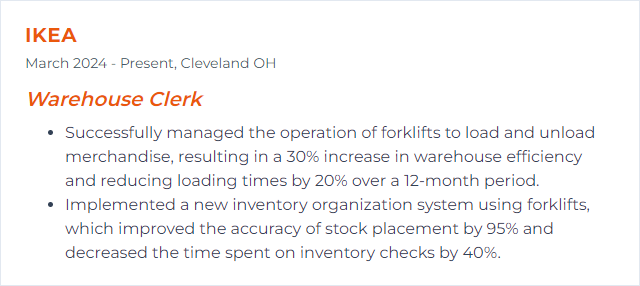
3. SAP ERP
Enterprise software that ties inventory, orders, and warehouse tasks into one source of truth. In many operations this includes SAP S/4HANA with Embedded EWM or SAP EWM for advanced warehousing.
Why It's Important
It reduces manual touches, improves inventory accuracy, and streamlines moves from receiving to shipping. Fewer errors, faster picks, cleaner data.
How to Improve SAP ERP Skills
- Standardize master data: Clean SKUs, units of measure, and storage types. Bad masters create bad outcomes.
- Scan at every touch: Drive real-time postings for putaway, picking, and transfers. Ditch paper lag.
- Use task interleaving: Combine picks, replenishments, and putaways to cut empty travel.
- Go mobile: Handhelds with simple Fiori screens or RF transactions keep operators moving.
- Leverage rules: Putaway, picking, wave, and replenishment rules should match your layout and velocity profile.
- Train with scenarios: Practice exceptions—short picks, substitutions, partial receipts—so the team reacts fast.
How to Display SAP ERP Skills on Your Resume
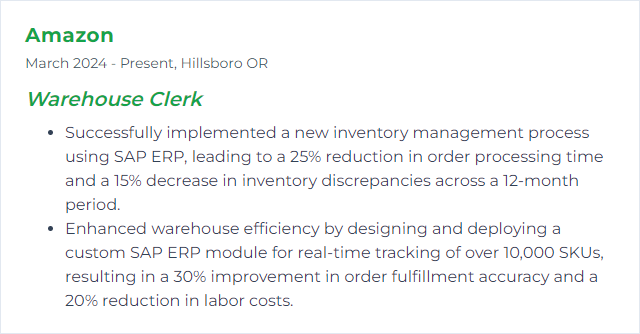
4. Oracle Inventory
Oracle’s inventory capabilities (on-prem or Oracle Cloud SCM) track quantities, locations, and movements, tying warehouse activity to purchasing, manufacturing, and fulfillment.
Why It's Important
It sharpens visibility, speeds reconciliations, and anchors order accuracy. Less chasing. More shipping.
How to Improve Oracle Inventory Skills
- Real-time transactions: Record receipts, transfers, issues, and adjustments immediately. No end-of-day backlog.
- Automate data capture: Barcodes and RF flows for receiving, putaway, and picking reduce keystrokes and miskeys.
- Use advanced tracking: Lots, serials, and subinventories for traceability that actually works during recalls or audits.
- Tidy the org structure: Clear subinventory definitions, locators, and status controls prevent misplacement.
- Cycle count programs: Risk-based schedules and root-cause fixes for variances.
- Focused training: Short, role-based modules for clerks, leads, and supervisors—aimed at exceptions as much as the happy path.
How to Display Oracle Inventory Skills on Your Resume
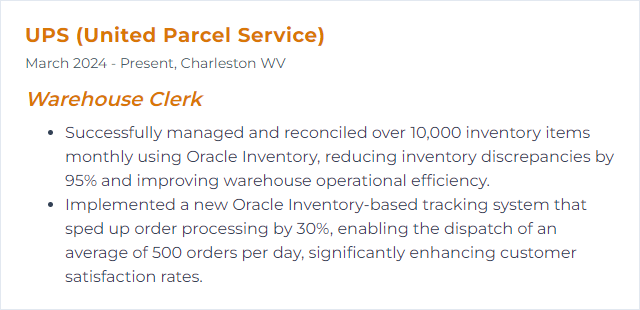
5. RF Scanning
Using handheld radio frequency devices to scan barcodes and update inventory instantly. Simple idea, big payoff.
Why It's Important
It accelerates receiving and picking, prevents fat-finger errors, and keeps the system aligned with reality.
How to Improve RF Scanning Skills
- Train to speed and accuracy: Aim, confirm, move. Teach shortcuts and error recovery.
- Maintain the gear: Batteries charged and rotated, lenses clean, buttons responsive, firmware current.
- Improve labels: High-contrast, scannable labels in consistent locations. No crumpled stickers on curved wrap.
- Strengthen Wi‑Fi coverage: Dead zones break workflows. Map and fix them.
- Standardize workflows: Consistent RF menus and prompts for receiving, putaway, picks, and moves reduce hesitation.
- Audit scan compliance: Spot-check that every move is scanned, not “remembered.”
How to Display RF Scanning Skills on Your Resume

6. Pallet Jack
Manual or powered equipment used to lift and move palletized goods. The everyday workhorse between racks and docks.
Why It's Important
Quick, safe movement of loads boosts throughput and protects both product and people.
How to Improve Pallet Jack Skills
- Inspect before use: Wheels, forks, handle, hydraulics. If it drags or leaks, tag it out.
- Load correctly: Center the weight, secure the pallet, keep forks fully under the load.
- Navigate smart: Pull on inclines, control speed, give pedestrians space, no sharp turns with raised loads.
- Lay out clean paths: Clear aisles, sensible staging, minimal tight-turn zones.
- Ergonomics matter: Use neutral wrist positions and body alignment to cut strain during long runs.
- Service on schedule: Grease, replace worn wheels, and fix handles before failure stops a shift.
How to Display Pallet Jack Skills on Your Resume

7. Microsoft Excel
Spreadsheet power for organizing counts, reconciling orders, and spotting trends. From quick pivots to tidy audits.
Why It's Important
It supports clean data, fast analysis, and clear reporting. When the WMS can’t do it, Excel usually can.
How to Improve Microsoft Excel Skills
- Master core formulas: SUM, AVERAGE, COUNT, MIN/MAX, IF—bread and butter for daily ops.
- Lookup skills: VLOOKUP/XLOOKUP, INDEX/MATCH for sku cross-references and reconciliations.
- Data validation: Drop-downs and rules to keep entries consistent and mistake-resistant.
- Pivot tables: Summarize activity by SKU, zone, shift—insight without fuss.
- Conditional formatting: Flag negative inventory, late orders, or aging stock at a glance.
- Clean data fast: Flash Fill, Text to Columns, TRIM, and Power Query for messy files.
- Macros when it’s repeatable: Automate import, format, and export steps to save minutes every day.
How to Display Microsoft Excel Skills on Your Resume
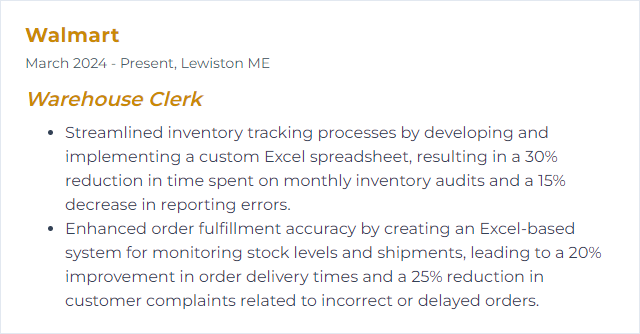
8. WMS (Warehouse Management System)
Software that runs warehouse operations: receiving, putaway, inventory, picking, packing, and shipping. The digital backbone of the floor.
Why It's Important
It reduces manual work, increases accuracy, and keeps orders flowing with fewer stops and starts.
How to Improve WMS (Warehouse Management System) Skills
- Role-based training: Short modules for clerks, pickers, and leads. Teach exceptions, not just the sunny day flow.
- Data discipline: Accurate item masters, UOMs, locations, and barcodes. Garbage in, chaos out.
- Mobilize everything: Handhelds for scans and updates on the move. Paper slows and slips.
- Tune slotting and paths: Use WMS heatmaps and travel histories to shrink footsteps.
- Automate the routine: Wave planning, replenishment triggers, cartonization, label generation—let the system decide.
- Integrate upstream/downstream: Clean connections to carriers, ERP, and storefronts to prevent rekeying.
- Measure and iterate: Track pick rate, dock-to-stock time, and order accuracy. Reconfigure what drags.
How to Display WMS (Warehouse Management System) Skills on Your Resume
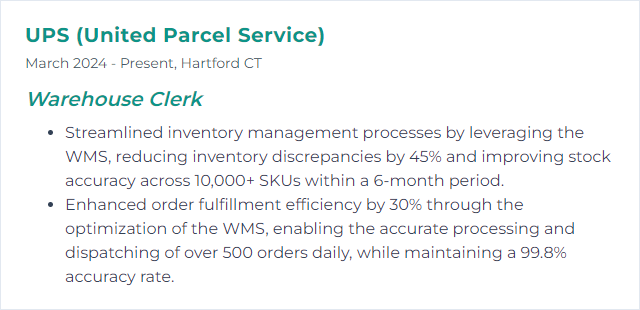
9. Order Picking
Selecting the right items, in the right quantities, on time. The last mile inside the building.
Why It's Important
Picking accuracy and speed determine fulfillment performance. Miss here and everything downstream pays for it.
How to Improve Order Picking Skills
- Choose the right method: Batch, zone, wave, pick-to-light, or voice—match the method to order profiles and volume.
- Tighten slotting: Place top movers at ergonomic heights and near pack stations. Reduce bends, reaches, and walks.
- Guide with the system: RF-directed tasks with confirmations (location, item, quantity) curb mispicks.
- Reduce touches: Use cartonization and direct-to-ship paths to skip unnecessary staging.
- Quality gates: Add quick scans or weight checks at pack-out for high-risk SKUs.
- Keep gear ready: Charged scanners, durable totes, and carts designed for the route.
How to Display Order Picking Skills on Your Resume

10. Shipping Procedures
Prepare, pack, label, document, and hand off goods to carriers—while updating systems so customers and teams know what moved.
Why It's Important
Shipping done right prevents delays, damages, and billing issues. It’s the final handshake with the customer.
How to Improve Shipping Procedures Skills
- Standardize packing: Correct box sizes, dunnage, and seals. Fragile items get the treatment they deserve.
- Label with confidence: Clear, compliant labels and scannable barcodes. Place them where scanners can find them fast.
- Mind DIM weight: Measure and weigh accurately to prevent carrier adjustments and surprise costs.
- Prep documents early: BOLs, customs forms, and ASNs generated from system data—no retyping.
- Schedule smart: Align pick/pack completion with carrier cutoffs. Keep a visible countdown on the floor.
- Seal the chain of custody: Scan at pack, at staging, and at trailer load. No mysteries after the fact.
- Audit exceptions: Investigate damages, returns, and missed scans. Fix root causes, not symptoms.
How to Display Shipping Procedures Skills on Your Resume
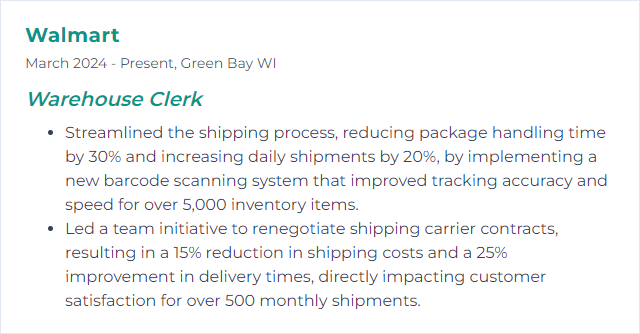
11. Safety Compliance
Working to established safety rules and regulations to prevent injuries, equipment damage, and avoidable downtime.
Why It's Important
Safe warehouses move faster. Compliance protects people, product, and the operation’s license to run.
How to Improve Safety Compliance Skills
- Train and refresh: New hires and veterans alike—equipment, materials handling, hazard awareness.
- PPE without compromise: Safety shoes, vests, gloves, eye and hearing protection as the job demands.
- Clear procedures: Lockout/tagout, spill response, battery charging, fall protection. Posted and practiced.
- Inspect and maintain: Racking, equipment, and aisles kept in safe condition. Fix hazards fast.
- Plan for emergencies: Drills, clear exits, and rally points. Everyone knows the plan.
- Report and learn: Simple near-miss and incident reporting. Analyze, share, and prevent repeats.
How to Display Safety Compliance Skills on Your Resume
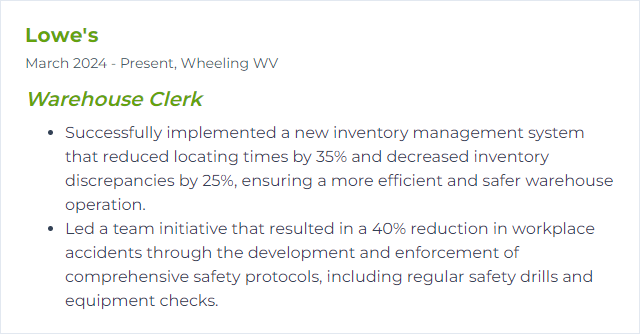
12. Quality Control
Checking goods—incoming and outgoing—for the right item, quantity, and condition. Stop defects at the door, and before they hit the truck.
Why It's Important
Quality control reduces returns, protects the brand, and keeps customers trusting the next shipment.
How to Improve Quality Control Skills
- Define acceptance standards: Clear specs, photos, and defect definitions for each SKU. No guessing on the dock.
- Use sampling wisely: AQL-style sampling for large receipts; 100% checks for high-risk items.
- Tag and quarantine: Isolate nonconforming product immediately with visible status and location control.
- Close the loop: Track defects to source—supplier, process, packaging—and drive corrective actions.
- Weigh and verify: Scales and dimensioners catch wrong counts and substitutions at pack-out.
- Monitor trends: Dashboards for defect rates, top offenders, and repeat issues. Fix what’s chronic.
- Train the eye: Short, frequent refreshers with real examples sharpen inspection consistency.
How to Display Quality Control Skills on Your Resume

